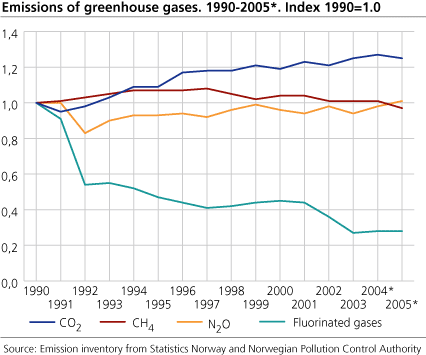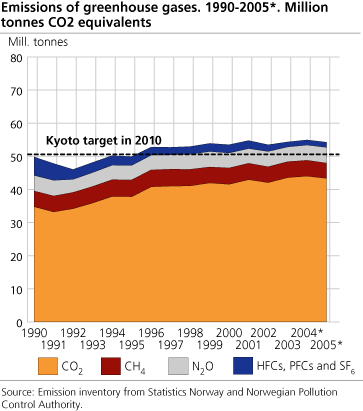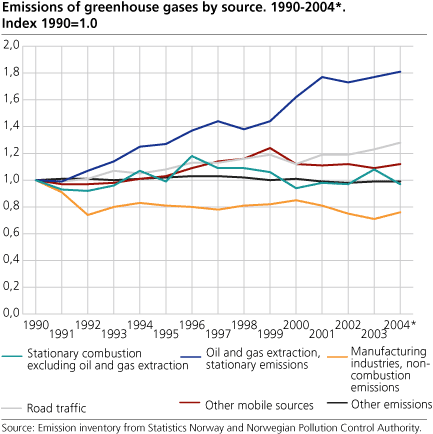Content
Published:
This is an archived release.
More use of electricity gave less greenhouse gas emissions
In 2005, the Norwegian greenhouse gas emissions decreased by 700 000 tonnes, or 1 per cent. The reason was a reduction in use of oil for heating, due to high oil prices. There has also been reduction in emissions from parts of the emission-intensive manufacturing industries.
The Norwegian greenhouse gas emissions were 700 000 tonnes CO2 equivalents, or 1 per cent, lower in 2005, compared with the previous year. This is shown in preliminary calculations from Statistics Norway and the Norwegian Pollution Control Authority.
One important reason for this decrease is that use of heating oils were reduced by 25 per cent, probably due to high prices. This led to use of electricity instead of oil, both in households and in manufacturing and other industries.
The other main reason is reduced process emissions from the manufacturing industries, mainly due to lower production in some industries with high emissions. However, in some industries, such as production of aluminium, both the production and the emissions were higher in 2005 than in 2004.
Continued increase in emissions from transport
Road traffic and oil and gas production are the most important sources of growth in CO2 emissions from 1990 to 2004. Road traffic emissions increased also in 2005, together with emissions from domestic shipping and domestic air transport. Growth in these transport activities led to more use of transport oils and thus increased emissions. However, the preliminary figures for domestic shipping are highly uncertain. Emissions from international sea and air traffic are not included.
Emissions from oil and gas activities in 2005 were unchanged compared with 2004. Due to measures to reduce NMVOC emissions from loading of oil, CO2 emissions remained stable while NOx emissions increased from 2004 to 2005.
There is a great deal of uncertainty connected to the preliminary emission figures distributed by source. More accurate 2005 data for the different emission sources will be publicized in February 2007.
Probably not a trend
Even though the greenhouse gas emissions decreased in 2005, it cannot be assumed that this is the beginning of a declining trend. The emissions from road traffic have increased almost every year since 1990, and are expected to do so also in the next years. The CO2 emissions from oil and gas activities are expected to grow considerably in the coming years, as gas production not yet has reached its peak.
The expectances for CO2 emissions from oil and gas activities are that there will be a considerable growth in the next years, as the gas production not yet has reached its peak.
9 per cent growth since 1990
By ratifying the Kyoto Protocol, Norway is committed to limit its emissions of greenhouse gases in the period 2008-2012. Norway has a national quota that is 1 per cent higher than the 1990 emissions. If the limit is exceeded, Norway must buy quotas through the Kyoto mechanisms.
In the period from 1990 to 2005, the total greenhouse gas emissions have increased by 9 per cent, or 4.5 million tonnes CO2 equivalents. As mentioned before, the growth has mainly been caused by increased emissions from road traffic and oil and gas extraction.
About the Kyoto Protocol
163 countries have ratified the Kyoto Protocol (18 April 2006). Of these, Norway is one among 36 industrialised countries, which have a national quota (assigned amount) for the period 2008-2012. These countries have committed themselves to carry out measures to reduce their domestic emissions, but an absolute limit for the countries’ emissions in this period has not been set. If their emissions exceed their quotas, they must make use of the Kyoto mechanisms, which make it possible to buy emission quotas from other countries with national quotas, or finance projects for reduction of emissions in developing countries (CDM - Clean Development Mechanism).
Greenhouse gases include the six gases comprised by the Kyoto Protocol: carbon dioxide (CO2), methane (CH4), nitrous oxide (N2O), hydrofluorocarbons (HFCs), perfluorocarbons (PFCs) and sulphur hexafluoride (SF6). CO2 made up almost 80 per cent of the greenhouse gas emissions in 2005. Since 1990, CO2 emissions have increased by 25 per cent, whereas emissions of fluorinated gases have been reduced by 72 per cent.
( read more ).
Norway's quota in the Kyoto period will be settled
The figures presented here will be reported to the United Nations Framework Convention on Climate Change (UNFCCC) and the 1990 figures will form the basis for Norway’s emission quota for the Kyoto period 2008-2012.
Other article published today
Emissions of nitrogen oxides, sulphur dioxide, ammonia and NMVOCs
Documentation
The Norwegian Emission Inventory. Documentation of methodologies for estimating emissions of greenhouse gases and long-range transboundary air pollutants (Rapport 2005/28) (New version will be published before the summer.)
More figures in StatBank
Tables:
This page has been discontinued, see Emissions to air, Annually.
Contact
-
Trude Melby Bothner
E-mail: trude.melby.bothner@ssb.no
tel.: (+47) 40 81 14 25
-
Berit Storbråten
E-mail: berit.storbraten@ssb.no
tel.: (+47) 40 81 14 23



